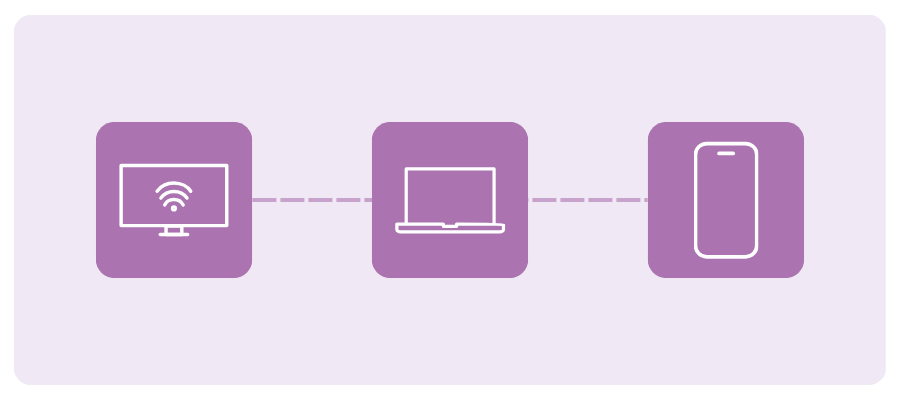At A Glance
Infillion and Experian collaborate to help advertisers connect with audiences across devices and channels, as cookies and mobile identifiers disappear. By integrating Experian's Digital Graph and Offline Identity Resolution, Infillion strengthens identity connections, improves campaign reach, and enhances audience engagement across CTV, mobile, and web.In our Ask the Expert Series, we interview leaders from our partner organizations who are helping lead their brands to new heights in AdTech. Today’s interview is with Ben Smith, VP of Product, Data Products at Infillion.
Adapting to signal loss
What does the Experian–Infillion integration mean for advertisers looking to reach audiences as signals fade?

As cookies and mobile identifiers disappear, brands need a new way to find and reach their audiences. The Experian integration strengthens Infillion’s XGraph, a cookieless, interoperable identity graph that supports all major ID frameworks, unifying people and households across devices with privacy compliance, by providing a stronger identity foundation with household- and person-level data. This allows us to connect the dots deterministically and compliantly across devices and channels, including connected TV (CTV). The result is better match rates on your first-party data, more scalable reach in cookieless environments, and more effective frequency management across every screen.
Connecting audiences across channels
How does Experian’s Digital Graph strengthen Infillion’s ability to deliver addressable media across channels like CTV and mobile?

Experian strengthens the household spine of XGraph, which means we can accurately connect CTV impressions to the people and devices in that home – then extend those connections to mobile and web. This lets us plan, activate, and measure campaigns at the right level: household for CTV, and person or device for mobile and web. The outcome is smarter reach, less waste from over-frequency, and campaigns that truly work together across channels.
The value of earned attention
Infillion has long championed “guaranteed attention” in advertising. How does that philosophy translate into measurable outcomes for brands?

Our engagement formats, such as TrueX, are based on a simple principle: attention should be earned, not forced. Viewers choose to engage with the ad and complete an action, which means every impression represents real, voluntary attention rather than passive exposure. Because of that, we consistently see stronger completion rates, deeper engagement, and clearer downstream results – like lower acquisition costs, improved on-site behavior, and measurable brand lift.
To take that a step further, we measure attention through UpLift, our real-time brand lift tool. UpLift helps quantify how exposure to a campaign influences awareness, consideration, or purchase intent, providing a more complete picture of how earned attention translates into business impact.
Creative innovation and location insights
Beyond identity resolution, what are some of Infillion’s capabilities, like advanced creative formats or location-based insights, that set you apart in the market?

One key area is location intelligence, which combines privacy-safe geospatial insights with location-based targeting through our proprietary geofencing technology. This allows us to build custom, data-driven campaigns that connect media exposure to real-world outcomes – like store visits and dwell time – measured through Arrival, our in-house footfall attribution product.
We also build custom audiences using a mix of zero-party survey data, first-party location-based segments, and bespoke audience builds aligned to each advertiser’s specific strategy.
Then there’s creative innovation, which is a major differentiator for us. Our high-impact formats go beyond static display, such as interactive video units that let viewers explore products through hotspots or carousels, rich-media ads that feature polls, quizzes, dynamic distance, or gamified elements, and immersive experiences that encourage active participation rather than passive viewing. These creative formats not only capture attention but also generate deeper engagement and stronger performance for a variety of KPIs.
Future ready media strategies
How does Infillion’s ID-agnostic approach help brands future-proof their media strategies amid ongoing privacy and tech changes?

We don’t put all our eggs in one basket. XGraph securely unifies multiple durable identifiers alongside our proprietary TrueX supply to strengthen CTV household reach. This agnostic design allows us to adapt as platforms, regulations, and browsers evolve – so you can preserve reach and measurement capabilities without getting locked into a single ID or losing coverage when the next signal deprecates.
Raising the bar for media accountability
Looking ahead, how is Infillion evolving its platform to meet the next wave of challenges in audience engagement and media accountability?
From an engagement standpoint, we’re expanding our ability to support the full customer journey, offering ad experiences that move seamlessly from awareness to consideration to conversion. That includes smarter creative that adapts to context, intelligent targeting and retargeting informed by real data, and formats designed to drive measurable outcomes rather than just impressions.
When it comes to accountability, we’re ensuring that measurement is both flexible and credible. In addition to our proprietary tools, we partner with leading third-party measurement providers to validate results and give advertisers confidence that their investment is truly performing. Within our DSP, we emphasize full transparency and log-level data access, ensuring advertisers can see exactly what’s happening on every impression.
All of this builds toward the next era of agentic media buying – one enabled by our MCP suite and modular, component-based tools. This evolution brings greater accountability and next-generation audience engagement to an increasingly automated, intelligent media landscape. Our goal is to help brands connect more meaningfully with audiences while holding every impression – and every outcome – to a higher standard of transparency and effectiveness.
Driving impact across the funnel
What is a success story or use cases that demonstrate the impact of the Experian–Infillion integration?
We recently partnered with a national veterans’ organization to raise awareness of its programs for injured or ill veterans and their families. Using the Experian integration, we combined persistent household- and person-level identifiers with cross-device activation to reach veteran and donor audiences more precisely across CTV, display, and rich media. The campaign achieved standout results – industry-leading engagement rates, a 99% video completion rate, and measurable lifts in both brand awareness (3.6 % increase) and donation consideration (13.7% lift). It’s a clear example of how stronger identity and smarter activation can drive meaningful outcomes across the full funnel.

Contact us
FAQs
Identity resolution ensures accurate connections between devices, households, and individuals. Experian’s Offline Identity Resolution and Digital Graph strengthen these connections for improved targeting and consistent measurement across CTV, mobile, and web.
Solutions like Experian’s Digital Graph enable brands to connect first-party data to household and person-level identifiers, ensuring scalable reach and compliant audience targeting legacy signals fade.
Focusing on earned attention (where audiences actively choose to engage) leads to stronger completion rates, improves on-site behavior, and drives measurable increases in brand awareness and consideration.
By linking CTV impressions to households and extending those connections to mobile and web, Experian’s identity solutions ensure campaigns work together seamlessly, reducing over-frequency and improving overall reach.
About our expert

Ben Smith, VP Product, Data Products
Ben Smith leads Infillion’s Data Products organization, delivering identity, audience, and measurement solutions across the platform. Previously, he was CEO and co-founder of Fysical, a location intelligence startup acquired by Infillion in 2019.
About Infillion

Infillion is the first fully composable advertising platform, built to solve the challenges of complexity, fragmentation, and opacity in the digital media ecosystem. With MediaMath at its core, Infillion’s modular approach enables advertisers to seamlessly integrate or independently deploy key components—including demand, data, creative, and supply. This flexibility allows brands, agencies, commerce and retail media networks, and resellers to create tailored, high-performance solutions without the constraints of traditional, all-or-nothing legacy systems.
Latest posts

Consumers engage with content and advertisements across various devices and platforms, making an identity framework essential for establishing effective connections. An identity framework allows businesses to identify consumers across multiple touchpoints, including the relationships among households, individuals, and their devices. Combined with a robust data framework, businesses can understand the relationship between households, individuals, and marketing attributes. Consequently, businesses can tailor and deliver personalized experiences based on individual preferences, ensuring seamless consumer interactions across their devices. We spoke with industry leaders from Audigent, Choreograph, Goodway Group, MiQ, Snowflake, and others to gather insights on how innovations in data and identity are creating stronger consumer connections. Here are five key considerations for advertisers. 1. Embrace a multi-ID strategy Relying on a single identity solution limits reach and adaptability. Recent data shows that both marketers and agencies are adopting multiple identity solutions. By embracing a multi-ID strategy with solutions like Unified I.D. 2.0 (UID2) and ID5, brands can build a resilient audience targeting and measurement foundation, ensuring campaigns remain effective as identity options evolve across channels. A diversified identity approach ensures that advertisers are not left vulnerable to shifts in technology or policy. By utilizing multiple ID solutions, brands can maintain consistent reach and engagement across various platforms and devices, maximizing their campaign effectiveness. "I don't think it will ever be about finding that one winner…it's going to be about finding the strengths and weaknesses and what solutions drive the best results for us."Stephani Estes, GroupM 2. Utilize AI and machine learning to enhance identity graphs Identity graphs help marketers understand the connections between households, individuals, their identifiers, and devices. This understanding of customer identity ensures accurate targeting and measurement over time. AI and machine learning have become essential in making accurate inferences from less precise signals. These technologies strengthen the accuracy of probabilistic matches, allowing brands to understand consumer behavior more effectively even when data fidelity is lower. Adopting a signal-agnostic approach and utilizing various ID providers enhances the ability to view consumers' movements across platforms. This strategy moves measurement beyond isolated channels, providing a holistic understanding of campaign effectiveness and how different formats contribute to overall performance. By integrating AI and machine learning into identity graphs, advertisers can develop more cohesive and effective marketing strategies that guide customers seamlessly through their buying journey. "What we're finding is more and more identity providers are using Gen AI to locate connections of devices to an individual or household that maybe an identity graph would not identify."David Wells, Snowflake 3. Balance privacy with precision using AI AI-driven probabilistic targeting and identity mapping provide effective solutions for privacy-focused advertising. Rather than relying on extensive personal data like cookies, AI can use limited, non-specific information to predict audience preferences accurately. This approach allows advertisers to reach their target audience while respecting privacy—a crucial balance as the industry shifts away from traditional tracking methods. According to eMarketer, generative AI can further enhance audience segmentation through clustering algorithms and natural language processing. These tools enable more granular, privacy-compliant targeting, offering advertisers a pathway to reach audiences effectively without needing third-party cookies. "I think the biggest opportunity for machine learning and AI is increasing the strength and accuracy of probabilistic matches. This allows us to preserve privacy by building models based on the features and patterns of the consumers we do know, instead of transmitting data across the ecosystem."Brian DeCicco, Choreograph 4. Activate real-time data for better engagement Real-time data enrichment introduces dynamic audience insights into the bidding process, enabling advertisers to respond instantly to user actions and preferences. This agility empowers marketers to craft more relevant and impactful moments within each campaign. "Real-time data enrichment–where data companies can have a real-time conversation with the bid stream–is an exciting part of the future, and I believe it will open the door to activating a wide variety of data sets."Drew Stein, Audigent 5. Create and deploy dynamic personas using AI Generative AI transforms persona-building by providing advertisers with richer audience profiles for more precise targeting. This approach moves beyond traditional demographic categories, allowing for messaging that connects more meaningfully with each consumer. By using generative AI to craft detailed personas, advertisers can move beyond generic messaging to create content that truly resonates on an individual level. This personalized approach captures attention and strengthens consumer relationships by addressing their specific needs and interests. "One cool thing we've built recently is a Gen AI-based personas product that generates personas to create highly sophisticated targeting tactics for campaigns."Georgiana Haig, MiQ Seize the future of data-driven engagement Focusing on these five key innovations in data and identity allows you to adapt to the evolving media landscape and deliver personalized experiences to your audience. Contact us Latest posts

Originally appeared on Total Retail Retail media networks (RMNs) continue to demonstrate how they can be a powerful monetization driver for retailers, creating a win-win-win for everyone involved. Retailers can monetize their valuable first-party data as well as their online and in-store inventory, while customers benefit from timely, relevant content that enhances their shopping experience. At the same time, advertisers can reach highly targeted audiences at critical moments near the point of purchase Achieving this type of success requires overcoming challenges around fragmented and incomplete first-party data, which can limit a retailer's ability to organize and use their data effectively. Additionally, many RMNs lack the analytical capacity to generate customer insights, build addressable audiences, and accurately measure success. To realize the full potential of their platforms, RMNs need partners that provide complementary data, strong identity solutions, and the expertise to transform insights into actionable strategies. This allows RMNs to drive winning outcomes for themselves, marketers, and their customers. Here are the five steps an RMN should consider when selecting the right partner. 1. Build an identity foundation First, the right partner needs to be able to organize and clean customer data. Given the millions of customer records and data points that a retailer has, RMNs need to make sure their data is highly usable. Whether it is a known customer record or an unknown customer with incomplete data, partners should fill in missing information and connect fragmented customer records to a single profile. For example, RMNs need to know that a purchase made in-store is by the same customer who bought online. The best partners will then organize those profiles into households since targeting (and purchasing) is often done at the household level. Without a strong identity foundation future steps of segmentation, insights, audience creation, and activation will not be successful. Experian identity Experian's identity solutions provide RMNs with a comprehensive and accurate view of their customers across both offline and digital environments. We clean an RMN's first-party data and organize their customer records into households since targeting is often done at the household level and purchases are made at the household level. Using Experian's Offline and Digital Graphs we work with the RMN to fill in the missing information they have on their customers (e.g. name, address, phone number or digital IDs like hashed emails, mobile ad IDs, CTV IDs, Universal IDs like UID2 or ID5 IDs). This ensures that the retailers' entire customer base can be reached – and measured – across devices and channels. 2. Segment your customers An RMN’s ability to segment its customer base and derive insights depends on the availability and usability of their data assets – not to mention some serious analytical chops. Some RMNs will split their customers into different product segments based on what’s relevant to an advertiser. For example, a home improvement retailer may segment customers by who is buying DIY supplies versus improvement services. Other RMNs may develop custom segments from their customer data and third-party data sources, so that advertisers can personalize their marketing based on life stage, age, income level, geography, and other factors. Either approach is effective but requires working with a partner who has high quality data and deep analytical expertise to develop those segments. Segment with Experian Experian Marketing Data helps an RMN learn about their customer beyond their first-party data. With access to 5,000 marketing attributes, RMNs can fill in the holes in their understanding of a customer. We provide them with demographic, geographic, finance, home purchase, interests and behaviors, lifestyle, auto data and more. RMNs can use this enriched data set to create addressable audience segments. 3. Generate actionable insights about these segments Once the RMN determines how they will segment their customers, they can utilize demographic, attitudinal, interest, and behavioral data from a trusted partner to develop a customer profile that compares its customers against a relevant sample of consumers. Here, the RMN will gain insight that will help them answer questions about its customers. Examples include: What age and income groups are more likely to purchase my product? What is the current life stage of my customers – do they have children, are they married, are they empty-nesters? Is price or quality more important to customers in their decision-making process? What sort of activities do my customers enjoy? How frequently do my customers shop for similar merchandise? What media channels do my customers use to get their information? Expanded insights with Experian With Experian’s advanced customer profiling, RMNs can go beyond basic customer segmentation. We build detailed customer profiles by utilizing accurate, attribute-rich consumer data, so RMNs can gain a more comprehensive understanding of their customer’s preferences, life stages, and purchasing behaviors. Having this insight enables the RMN to: Design a targeted email campaign promoting home essentials to recently married new homeowners. Develop a social media post announcing the opening of a new hardware store to users within a specific location interested in do-it-yourself products. Create brochures and flyers at a local community event tailored towards parents with small children that promote equipment for youth sports leagues. 4. Create high quality lookalike audiences The RMN now knows what distinguishes their customers from other consumers and can create audiences that enable advertisers to run personalized marketing campaigns at scale. RMNs can do this in several different ways: Work with a data provider who can create custom audiences for the RMN (e.g., Ages 40-49 and Leisure Travelers and past purchase of travel item) These custom audiences are created by joining multiple first- and third-party data attributes found to be significant in the customer profile or using machine learning techniques to develop a custom audience unique to the advertiser. Custom audiences with Experian With an enriched understanding of their customers, RMNs can create addressable custom audience segments, including lookalike audiences, for advertisers. 5. Expand addressability of audiences and activate on multiple destinations Once audiences are created, RMNs will want to increase a marketer’s reach across on-site and off-site channels. With the right identity graph partner, an RMN can add digital identifiers to customer records that enable activation across media channels, including programmatic display, connected television (CTV), or social. RMNs should work with identity providers that are not reliant on third-party cookies. They should select partners that offer more stable digital IDs in their graph like mobile ad IDs (MAIDs), hashed emails (HEMs), CTV IDs, and universal IDs like Unified I.D. 2.0 (UID2). Experian powers data-driven advertising through connectivity Using Experian's Digital Graph, RMNs expand the addressability of their audiences by assigning digital identifiers to customer records. Marketers will be able to reach an RMNs customers onsite as well as offsite since Experian provides several addressable IDs. Audiences can be activated across an RMNs owned and operated platform as well as extended programmatically to TV and the open web through Experian's integrations across the ecosystem. Maximize your RMN’s revenue potential with Experian Organizing customer data, segmenting customers, generating insights, creating addressable audiences, and activating campaigns are all critical steps for an RMN to realize that revenue potential. RMNs should select a partner that provides the data, identity, and analytical resources to create the winning formula for marketers, customers, and retailers. Experian’s data and identity solutions are designed to help RMNs maximize their revenue potential. Reach out to our team to discover how we can support your path to RMN success. Connect with us Latest posts

Originally appeared on MediaPost As the digital ecosystem becomes more complex, managing multiple identifiers for consumers has emerged as a significant challenge. From cookies and IP addresses to mobile IDs and universal IDs, marketers and platforms face increasing difficulty in maintaining a unified view of their consumers. Without a coherent identity strategy, campaigns can suffer from poor targeting, limited personalization, and flawed attribution. Experian understands these challenges and offers solutions to help our partners navigate the complexities of a multi-ID landscape. By utilizing both digital and offline data, we provide the tools to unify fragmented identifiers and maintain a persistent view of consumers. As a result, marketers and platforms get rich insights, accurate cross-device targeting, improved addressability, and measurable advertising. The shifting identity landscape For years, the industry has relied on cookies to identify consumers across devices and platforms. However, with ongoing signal loss, including the uncertainty around cookies, and the evolution of privacy regulations, the digital identity landscape has grown more complicated. As consumers hop from one device to another, they are now represented by multiple signals, each tied to a different aspect of their digital behavior. While this shift brings complexity, it also opens the door for innovation. Marketers and ad platforms now have the opportunity to rethink their identity strategies and adopt more flexible approaches that are not reliant on a single identifier. This is where Experian comes in. Connecting the dots: A holistic view of the customer journey Our identity solutions are designed to help manage today’s multi-ID ecosystem by connecting digital and offline identifiers to a single customer profile. This creates a unified view of the consumer, and when combined with our understanding of customer behavior (e.g. demo, interests, shopping patterns) marketers and platforms get both insights about their customers and the addressability to reach them across channels. Four examples of what you can do with a strong identity foundation If an advertiser wants to make its first-party data more addressable, it can utilize our Digital Graph with universal IDs, hashed emails (HEMs), and connected TV (CTV) IDs to extend its reach. A publisher who wants to gain further insights into their audiences and create private marketplaces (PMPs) can achieve this goal with the use of our Digital Graph with hashed emails, universal IDs, mobile ad IDs (MAIDs), CTV IDs, and IPs. The publisher can use this in concert with Marketing Attributes to understand age, gender, household income, buying behavior, and more. The publisher can connect marketing attributes to the Digital Graph via our Living Unit ID (LUID) to understand more about consumers that fall into their segments. A demand-side platform (DSP) who wants to extend first-party and third-party audience reach across all digital devices on their platform will use the Digital Graph with all digital IDs to allow users of their platform to select cross-device extension against first-party and third-party audiences. A retail media network (RMN) can use our Offline and Digital Graphs to connect in-store and online purchases to a household profile—even when purchases are made by different people. The RMN can then reach that household across digital media platforms and accurately attribute the in-store purchase back to digital ad exposure. Identity as a strategic asset: Today and in the future In our paradoxical world where consumers are represented by multiple identifiers, yet marketers and platforms face signal loss, identity is more than a technical issue—it’s a strategic asset. The ability to unify identity data into a single profile provides marketers with the customer intelligence needed to drive growth and stay competitive. Here’s how we do it: Deep, persistent customer understanding: With roots in offline, deterministic data like names, addresses, and emails, we provide an accurate and persistent view of identity to our customers. This allows you to maintain a consistent and comprehensive understanding of your customers and their marketing attributes over time. Highly accurate and refreshed digital identities: Our signal-agnostic graph is not reliant on any one signal as it includes HEMs, cookies, MAIDs, IPs, Universal IDs, and CTV IDs. Our Digital Graph is updated weekly, ensuring the data is always fresh and addressable. This persistent linkage of individuals and households to their identifiers and devices means your campaigns are always targeting the right people. Connected offline and digital graphs for holistic insights: We connect offline and digital identities by following privacy-first best practices, such as preventing re-identification, to allow insights from the offline world to be used in the online world. This integrated approach, enriched with marketing data, gives you better insights, more addressable advertising, and the ability to engage customers across multiple devices while accurately measuring campaign impact. Transform challenges into opportunities The rise of the multi-ID landscape presents both challenges and opportunities for the advertising industry. We stand as the trusted partner to navigate this complexity, utilizing insights from the offline world to inform decisions in the online world, enabling personalized marketing and accurate attribution, and helping you achieve your current and future goals. Get started today Latest posts